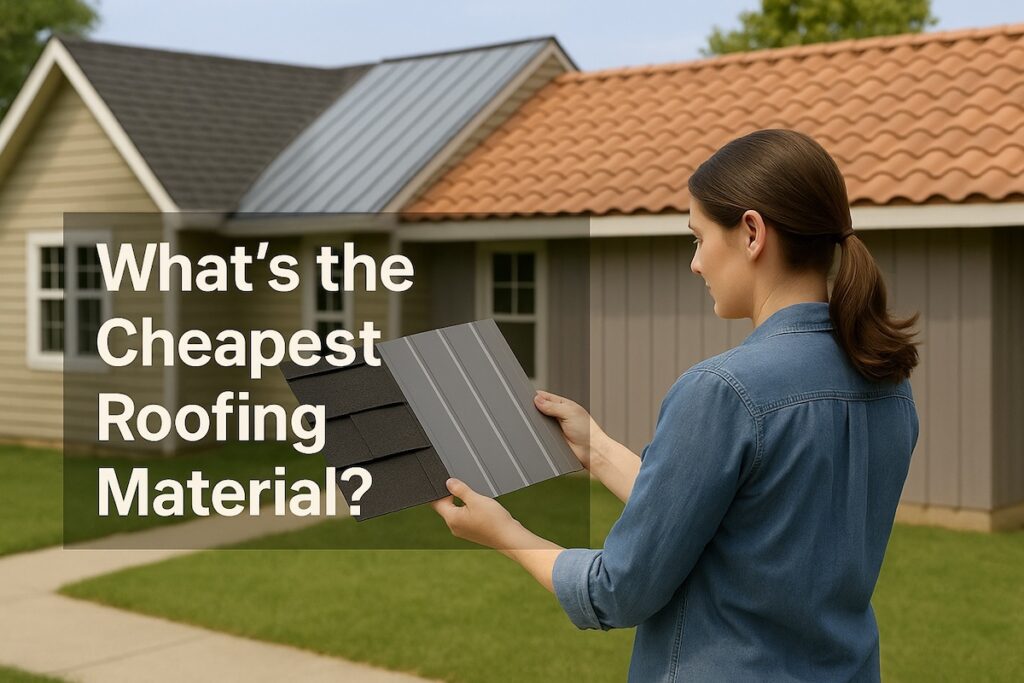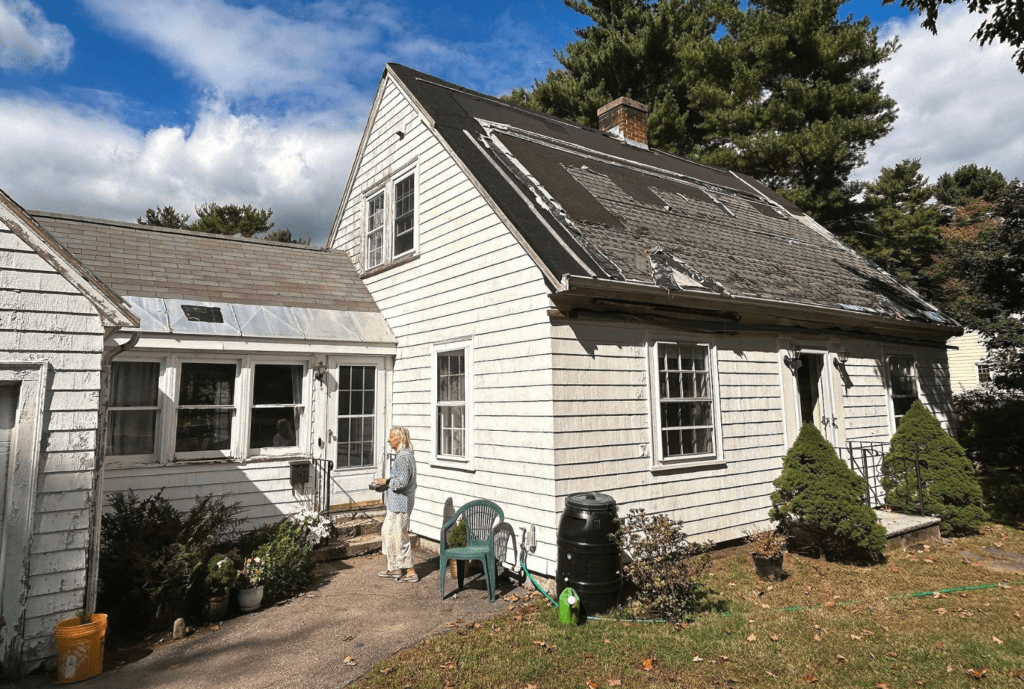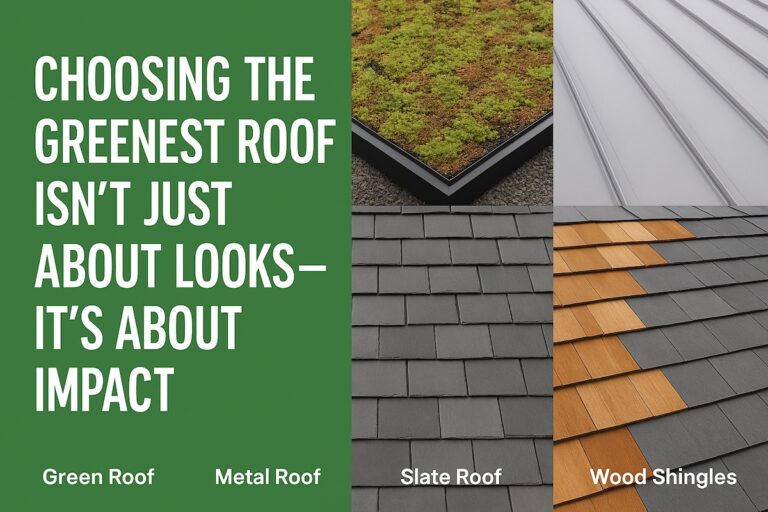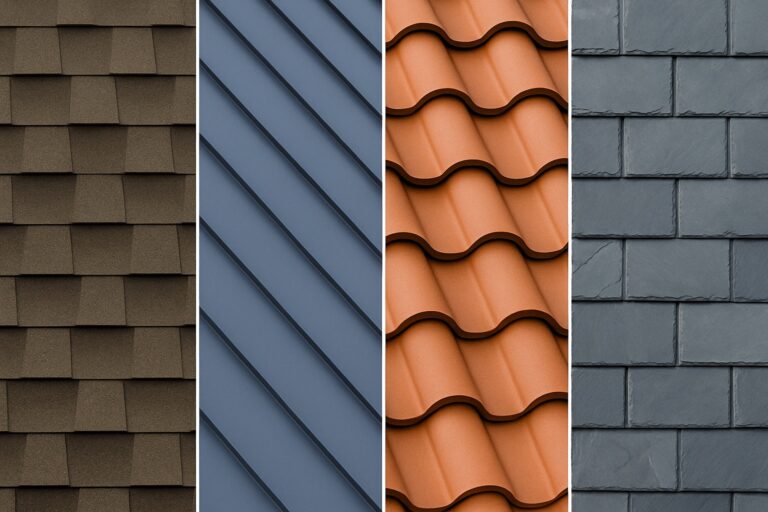-
Asphalt shingles are the most common affordable roof option—good for 15–30 years depending on the type.
-
Roll roofing is the cheapest roof material upfront, but it only lasts 5–10 years and is best for sheds or flat roofs.
-
Metal roofs have higher upfront costs but lower long-term costs due to their 40–70 year lifespan.
-
Architectural shingles cost slightly more than 3-tab asphalt shingles but offer better durability and curb appeal.
-
Slate and clay tiles are premium options with lifespans of 50–100+ years but come at a higher price.
-
Don’t forget: a roof replacement every 10 years adds up—durability, climate resistance, and roof system quality matter more than sticker price alone.
👉 Want help visualizing your options? Try our Roof Designer Tool to compare styles and materials before you commit.
Introduction
If you’re a homeowner staring down the cost of a new roof, you’re probably asking: what’s the cheapest roofing material that won’t come back to bite me later? After working with hundreds of homeowners and contractors, I can tell you this—there’s a big difference between an affordable roof and a cheap mistake.
In this guide, we’ll break down the real costs of different roof materials, not just the price per square foot but the total value over time—because replacing a roof too soon isn’t just frustrating, it’s expensive. Whether you’re comparing asphalt shingles, metal roofs, or other alternatives, this article will help you make a decision that saves money now and later.

Why “Cheapest” Isn’t Always Your Best Friend
I once worked with a client who bragged about scoring the “cheapest” roof in his neighborhood. Two years later? I was helping him create content for the roofing company replacing that same disaster. Cheap upfront sometimes means expensive down the road.
When hunting for cost-effective roofing options, you’ve gotta look beyond that initial price tag. Here’s what many contractors won’t tell you right away:
- A $4,000 roof that lasts 10 years costs you $400/year
- An $8,000 roof that lasts 30 years? Just $267/year
See what I’m getting at? The cheapest roof isn’t always the one with the lowest sticker price.
Hidden budget-killers include:
- Frequent maintenance (those $200-300 repair visits add up)
- Early roof replacement (replacing a roof twice in 20 years vs. once)
- Energy costs (some materials keep your home cooler/warmer than others)
- Insurance implications (some materials might lower your homeowner‘s insurance)
My neighbor went with the absolute cheapest roll roofing for his garage last year. Looked fine until those 60mph winds hit. Now he’s paying twice—and trust me, his wife hasn’t let him forget it!
The Cost vs. Quality Matrix (What Actually Matters)
Before diving into specific materials, let’s talk about what affects durability and overall value:
- Material Lifespan: Some roofing materials are naturally more durable than others. After seeing hundreds of roof replacements, I’ve noticed most homeowners underestimate just how big these differences are.
- Climate Resistance: Live in hurricane territory? Heavy snow country? Wildfire zone? Your local weather conditions should heavily influence your choice. I’ve seen perfectly good roofing materials fail spectacularly when installed in the wrong climate.
- Installation Quality: Even the best materials can fail with poor installation. A good roof contractor might charge more, but their expertise is worth every penny. (The horror stories I could tell you about DIY roof jobs gone wrong…)
- Maintenance Requirements: Some materials need regular TLC; others are practically “set it and forget it.”
The Real Contenders: Affordable Roofing Materials Ranked
Let’s get to the meat of it—what are your actual options when budget matters? I’ve ranked these based on initial cost, but stick around for the full picture.
1. Asphalt Shingles: The Popular Kid for a Reason
Price Range: $1-$4 per square foot installed Lifespan: 15-30 years
Asphalt shingle roofs dominate about 80% of the residential roof market, and for good reason. They’re affordable, relatively easy to install, and come in enough varieties to satisfy most aesthetic preferences.
Pro Tip: The jump from standard to architectural shingles is worth every penny. I upgraded my own roof from 3-tab to architectural shingles last year, and the difference in both appearance and durability is night and day.
Standard 3-tab shingles are your bare-minimum option. They’re flat and, frankly, a bit boring. Architectural shingles (sometimes called dimensional or laminate shingles) have more texture and typically last 5-10 years longer.
The asphalt shingle sweet spot? GAF’s Timberline HDZ or Owens Corning Duration series. Both offer solid warranties and performance without breaking the bank.
2. Roll Roofing: When Really Cheap Is The Priority
Price Range: $0.50-$1.50 per square foot installed Lifespan: 5-10 years
Look, I’m not going to sugarcoat it—roll roofing is the bottom-barrel option. It’s essentially asphalt material that comes in rolls instead of shingles.
Is roll roof the cheapest option on the market? Absolutely. But you get what you pay for.
I primarily recommend roll roofing for:
- Temporary solutions
- Sheds and outbuildings
- Very low-slope roofs where other options aren’t suitable
- When your budget is truly at rock bottom
My buddy used roll roofing on his workshop, and it’s held up decently for about 7 years now. The key? He doesn’t care much about how it looks, and he’s prepared to replace it entirely rather than repair it when it eventually fails.
3. Metal Roofing: The Long-Term Value Champion
Price Range: $5-$14 per square foot installed Lifespan: 40-70 years
“Wait,” you might say, “metal roofing isn’t cheap!” You’re right about the upfront cost, but stay with me here.
Metal roof materials come in several flavors:
- Corrugated metal panels (most affordable)
- Standing seam (mid-range but exceptional performance)
- Metal shingles (premium price, premium look)
The math makes sense for many homeowners: A metal roof might cost 2-3 times more than asphalt shingles initially but last 3-4 times longer with minimal maintenance.
I watched my parents install a standing seam metal roof on their forever home in 2010. Fifteen years later, it looks practically identical to when it was installed. Meanwhile, their neighbor has already replaced their asphalt roof once in that timeframe.
The biggest drawback? That initial sticker shock. But if you’re planning to stay put for more than 15 years, metal roofing often works out to be the most cost-effective option long-term.
4. Concrete Tiles: The Surprise Budget Option
Price Range: $4-$10 per square foot installed Lifespan: 50+ years
Concrete tile roofs offer the look of clay tiles without the premium price tag. They’re incredibly durable, fire-resistant, and can withstand some serious weather.
The catch? They’re heavy. Your roof structure needs to support the weight, which might mean additional costs for reinforcement if you’re replacing a lighter material.
Fun fact: I worked with a housing development in Arizona that used concrete tile roofs exclusively. Ten years later, not a single roof has needed replacement despite brutal sun and occasional hailstorms. That’s impressive ROI.
5. Clay Tile: Premium Looks, Premium Price
Price Range: $10-$18 per square foot installed Lifespan: 50-100 years (yes, really)
Clay tile roofing isn’t cheap by any stretch, but I’m including it because it’s the definition of “buy once, cry once.” These roofs can literally outlast the mortgage—and sometimes the house itself.
A clay tile roof installation is an investment, not an expense. It adds significant resale value and can be a major selling point if you ever move.
If you love the Mediterranean or Spanish look and can swallow the upfront cost, clay tile roofs offer unmatched durability and timeless appeal.
6. Slate: The Forever Roof
Price Range: $15-$30 per square foot installed Lifespan: 75-200 years
Slate roofing is the Rolls Royce of roofing materials. It’s stunningly beautiful, practically indestructible, and lasts generations. It’s also the most expensive option on this list by a substantial margin.
But here’s where it gets interesting: There are now synthetic slate options that deliver much of the aesthetic appeal at a fraction of the cost. These synthetic slate shingles typically run $7-$12 per square foot installed and last 40-50 years.
I recently toured a historic home restoration that used reclaimed slate from a demolished building. The slate tiles were over 100 years old and still in excellent condition. That’s the kind of longevity we’re talking about.
7. Wood Shingles: Natural Beauty at a Cost
Price Range: $6-$12 per square foot installed Lifespan: 25-30 years
Cedar and other wood shingles offer a distinctive, natural look that many homeowners love. They age to a beautiful silver-gray and provide good insulation.
The downsides? They require more maintenance than most other options and aren’t naturally fire-resistant (though they can be treated). They’re also not the most budget-friendly option.
I generally recommend wood shingles only to clients who are specifically looking for that aesthetic and are willing to commit to the maintenance requirements.
8. Rubber Roofing: The Flat Roof Solution
Price Range: $4-$8 per square foot installed Lifespan: 15-25 years
EPDM (rubber) roofing is primarily used for flat or low-slope roofs. It’s relatively affordable, durable, and fairly easy to repair if damaged.
I’ve seen rubber roof systems perform exceptionally well on commercial buildings and modern homes with flat roof sections. It’s not the sexiest option, but it’s functional and economical for the right application.


ROOFING VISUALIZER TOOL
See Your Home with a New Roof in Seconds
Help your homeowners visualize new roofing and colors on their own home with Renoworks’ AI technology in seconds.
- Easy-to-use interface designed for contractors and professionals working with homeowners.
The Bottom Line: Best Value for Different Budgets
After helping dozens of homeowners navigate roofing decisions, here’s my honest assessment for different budget scenarios:
Rock-Bottom Budget: 3-tab asphalt shingles. They’re not exciting, but they’ll keep the rain out for 15-20 years if properly installed.
Tight But Flexible Budget: Architectural asphalt shingles. The extra $15-25 per square (100 sq ft) over basic shingles is money well spent.
Medium Budget: Standing seam metal roofing. It’s the sweet spot of upfront affordability and long-term value.
Comfort Budget: Concrete tiles or synthetic slate. Both offer exceptional durability and curb appeal without the premium price of their natural counterparts.
Sky’s-the-Limit Budget: Natural slate or clay tile. These are lifetime investments that can actually increase your home’s value.
Final Thoughts: Making Your Decision
Choosing the right roof material ultimately comes down to balancing budget constraints with long-term goals. Are you planning to sell in 5 years or stay for 25? Is curb appeal a priority? How risk-averse are you to potential repairs?
Whatever you decide, get at least three quotes from reputable roofers. I’ve seen pricing vary by as much as 40% for identical materials and similar work scope.
Oh, and one last thing—don’t skimp on underlayment and proper ventilation, regardless of which roofing material you choose. I’ve seen too many affordable roofs fail prematurely because corners were cut on these essential components.
Your roof protects everything underneath it. Sometimes the cheapest option isn’t about price—it’s about value. Choose wisely, and you won’t be calling that roofer back anytime soon.
Frequently Asked Questions
What is the cheapest roofing material for a residential home?
Roll roofing is technically the cheapest roof material upfront, with costs as low as $0.50 per square foot installed. However, its lifespan is only 5–10 years, making it better suited for outbuildings or temporary solutions.
Are asphalt shingles still the best value for most homeowners?
Yes. Standard 3-tab asphalt shingles are budget-friendly and last around 15–20 years. Architectural shingles cost slightly more but offer longer durability and better aesthetics—making them a popular middle-ground option for affordable roofing.
Is a metal roof too expensive for a tight budget?
Not necessarily. While the initial cost of a metal roof is higher, its 40–70 year lifespan often makes it more cost-effective over time. Corrugated metal panels are typically the most budget-friendly metal option.
How can I make sure I’m not sacrificing quality for price?
Focus on roof material lifespan, installation quality, and climate compatibility. A slightly higher upfront cost can save you from early roof replacements and expensive repairs.
What’s the most cost-effective roof if I plan to sell soon?
Go with architectural asphalt shingles. They’re relatively low-cost, improve curb appeal, and appeal to future buyers without requiring a premium investment.
Are there any “hidden” costs in cheap roofing options?
Yes—frequent maintenance, poor insulation (higher energy bills), and shorter lifespan can make cheap materials more expensive long term. Always consider total lifetime cost, not just installation price.
Can a cheaper roof affect my home insurance?
Yes. Some materials like metal roofs or fire-resistant tiles can lower insurance premiums, while others may offer no benefits or even increase your rate due to risk factors.
Is DIY roof installation worth it to save money?
Usually not. Poor installation is a leading cause of premature roof replacement. Hiring a qualified roofer often saves money over time by avoiding costly issues later.


ROOFING VISUALIZER TOOL
See Your Home with a New Roof in Seconds
Help your homeowners visualize new roofing and colors on their own home with Renoworks’ AI technology in seconds.
- Easy-to-use interface designed for contractors and professionals working with homeowners.
Related Articles
Continue exploring this topic with these related articles, or read one of our case studies to see how visualization has helped remodelers save time and increase their profits.



